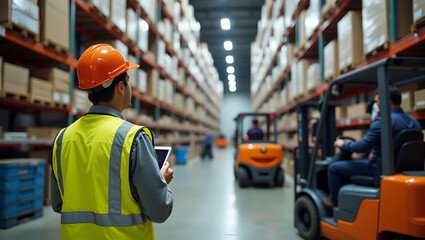Dropshipping vs 3PL: What’s the Difference and Which Is Right for You?
As a fulfillment partner working with both startups and established brands, we’ve seen the same question come up again and again: Should I start with dropshipping or invest in a 3PL? Both options promise convenience and scalability, but the way they operate—and the impact they have on your brand—are very different.
In this guide, we’ll break down how dropshipping and third-party logistics (3PL) differ, their pros and cons, and when each model makes the most sense. We’ll also explore a hybrid approach that combines the best of both worlds. By the end, you’ll know which fulfillment strategy fits your business stage and goals.

What Is Dropshipping?
Dropshipping is one of the most popular entry points into e-commerce. With this model, you don’t keep inventory yourself. Instead, when a customer places an order, you forward the request to a supplier or manufacturer who ships the product directly to the customer.
On paper, it sounds simple: no warehouses, no upfront investment in stock, and no handling logistics. But like every business model, dropshipping comes with strengths and weaknesses.
Advantages of Dropshipping
- Low startup costs: You don’t need capital for bulk inventory purchases.
- Minimal risk: No leftover stock if products don’t sell.
- Flexibility: Run your store from anywhere in the world.
- Product variety: Test and sell many items without committing to stock.
Disadvantages of Dropshipping
- Lower profit margins: You buy items individually, so your cost per unit is higher.
- Less control: Suppliers handle shipping, packaging, and sometimes even product quality.
- Longer delivery times: Many dropshipping suppliers ship internationally, leading to 2–6 week delivery times.
- Customer dissatisfaction risk: Late or inaccurate deliveries reflect on your brand, not the supplier.
What Is 3PL?
A third-party logistics (3PL) provider is a professional fulfillment company that stores your inventory in its warehouses and handles picking, packing, and shipping when orders come in. Unlike dropshipping, you own the products—you send them in bulk to your 3PL’s fulfillment centers. From there, the 3PL becomes your logistics partner, acting as an extension of your brand.
For growing businesses, a 3PL can unlock scalability, efficiency, and customer satisfaction that dropshipping struggles to match.
Advantages of 3PL
- More control: You decide product quality, packaging, and branding.
- Faster shipping: Many 3PLs operate local warehouses, offering 2–7 day delivery instead of weeks.
- Scalability: 3PLs handle seasonal peaks, promotions, and global expansion.
- Professional expertise: Advanced technology (WMS, real-time tracking) and experienced staff reduce costly errors.
- Branding opportunities: Custom packaging, inserts, and kitting options strengthen customer experience.
Disadvantages of 3PL
- Upfront investment: You must purchase inventory in advance.
- Service dependency: You rely on the 3PL’s reliability and systems.
- Storage risk: Unsold inventory still ties up capital.
Key Differences Between Dropshipping and 3PL
While both models remove the burden of personally shipping every order, they differ significantly in structure and impact:
- Inventory ownership: Dropshipping = no inventory; 3PL = you own stock.
- Costs: Dropshipping has low startup costs but higher per-unit costs; 3PL requires upfront investment but offers better long-term margins.
- Delivery times: Dropshipping often means 15–40 days; 3PL can ship in 2–7 days, sometimes next-day for local warehouses.
- Branding: Dropshipping limits customization; 3PL offers branded packaging and marketing inserts.
- Risk: Dropshipping risks unreliable suppliers; 3PL risks unsold inventory but provides stability.
When to Choose Dropshipping
From our experience, dropshipping makes sense when:
- You’re just starting and have very limited capital.
- You want to test new products without committing to bulk orders.
- You need flexibility to run your store part-time or from anywhere.
In short, dropshipping is a learning ground. It’s a way to validate ideas, experiment with product ranges, and enter e-commerce without heavy risk.
When to Choose 3PL
A 3PL is the better choice when:
- You have consistent or growing order volume.
- You want to build a brand with custom packaging and fast shipping.
- You’re expanding to multiple sales channels (Amazon, Shopify, TikTok, etc.).
- You need to handle seasonal demand spikes without losing reliability.
Simply put, if you’re serious about scaling and building customer loyalty, a 3PL provides the infrastructure you can’t replicate on your own.
Hybrid Approach: Using Both
Many successful sellers use dropshipping and 3PL together. For example:
- Test new products with dropshipping to reduce risk.
- Move proven products to 3PL for better margins, faster shipping, and branding control.
This strategy allows businesses to stay agile while building a reliable fulfillment backbone. It’s a practical way to balance experimentation with stability.
Conclusion & Next Steps
So, dropshipping vs 3PL—which is better? The answer depends on your stage and goals. If you’re just starting, dropshipping lowers your risks. But if you’re ready to scale and build a brand customers love, 3PL is the smarter long-term solution.
At HUIXIN (China-3PL), we’ve helped small startups evolve from dropshipping to full-scale 3PL operations. We know the growing pains of e-commerce, and we’re here to make your logistics simple, efficient, and scalable.
Talk to us today about how we can design a fulfillment strategy—whether dropshipping, 3PL, or a hybrid—that fits your vision and fuels your growth. Because at the end of the day, your logistics partner should grow with you.